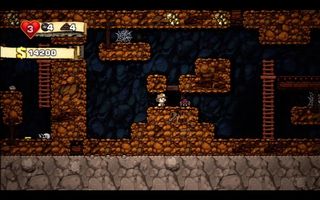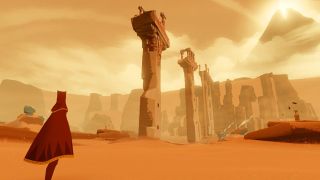Why Sony is being smarter with indie gaming than its rivals
Over the last eight years, Sony’s internal studios and third-party partnerships have produced a famously long string of artistic, off-kilter, experimental console games. In a slightly abstract way, that trait is an extension of the platform holder’s philosophy since the days of the PS1. Who else was putting out games like Parappa the Rapper as triple-A releases back then? Who else would let a studio like Team Ico take 12 years (so far) to (not) complete a trilogy? And of course, there’s now Sony’s forward-looking indie focus for the PS4 which, at this year’s Gamescom in particular, earned the platform-holder widespread plaudits for seemingly presenting the most modern, progressive approach to next-gen.
But how much of Sony’s open-minded, creative persona is genuine, and how much is PR bluster intended to score early jabs against a Microsoft now often perceived as unswerving and out-of-touch? Recently I had the chance to sit down with Richard Haggett and Richard Hogg--both of Honeyslug studio--designer and artist on upcoming PS3/PS4 indie game Hohokum. As creator of early Vita hit Frobisher Says, Honeyslug already has a decent amount of experience working on the more creative side of Sony’s line-up, and so seemed a prime source to talk about the current state of the company’s outlook. So talk we did. At length. And it rather turns out that Sony’s bright, new democratic future of 'interesting game design for all' feels like a very real thing.
Hogg, for example, sees Sony’s conspicuously game-focused direction with the PS4 as an important statement of intent itself.
“One, they’re definitely putting the focus back on video games rather than all the other Netflix bollocks, which is, I think, amazing. And also, I think indie games and unusual types of games are a big part of their message. Look at how big a part of both the E3 press conference and the Gamescom press conference that was. Mark Cerny talking about indie games. I don’t think that’s just lip-service either. I think they’ve realised that it is the future.”
Indeed, I myself was heartened by SCEA President Jack Tretton’s early comments regarding the PS4’s online marketplace, which seemed to imply an organic, non-compartmentalised storefront featuring games in all their forms, with price being the only distinguishing factor. Haggett seems to agree:
"Yeah, the absence of ghettos. We definitely don’t need any more Xbox Live Indie Games type channels. Because it’s insulting. It’s meaningless as well. When the biggest selling game on Xbox Live is Minecraft by an order of magnitude, and yet they have this thing called Xbox Live Indie Games… But yeah, it’s great to see Sony just rolling it into one place."

Of course, it’s easy for a cynical, world-weary journo to find less altruistic reasons for Sony’s move towards independent developers. Sony of course, does not have access to the almost limitless coffers enjoyed by Microsoft, and with several of its divisions in a fair bit of trouble over recent years, it needs to be more frugal about the way it launches a console. And it’s surely more cost effective, in terms of creating superficial impressions at least, to spend a publishing and marketing budget across a lot of small games to than risk it all on two or three big ones.
Sign up to the GamesRadar+ Newsletter
Weekly digests, tales from the communities you love, and more
But while that may or may not be the case (or part of it, at least), there is an unmistakable sense when talking to the Hohokum team that Sony’s brave new indie world stems from a place of genuine care for video game design, and is part of a progressive overall view on the changing shape of gaming. As Haggett mentions, while we discuss the evolution of gaming culture moving into next-gen:
“I think the other thing that’s happened over the last couple of years is that the power of large marketing budgets to command attention on games has been neutered somewhat by the ability of people to put Let’s Play videos on Youtube. And it’s about ‘Ah, what’s interesting to watch someone play? Is it Call of Duty, or is it Minecraft and Spelunky?’”
Indeed, it does feel like Sony is hitting this stuff at exactly the right time. There’s been a definite shift in the way that even the mainstream perceives games over the last couple of years. Perhaps fed by ennui at an over-long passing console generation, perhaps the product of developers’ increasing dissatisfaction with the rigidity of console publishing possibilities, PC gaming has made a major resurgence, and the eclectic mix of gaming that has resulted cannot be ignored by anyone. In fact, as a result of online gaming culture’s increasing shift towards YouTube, it’s almost impossible to avoid.

Hogg continues, with an anecdote to chill the average Activision suit to the bone:
“I was talking to a friend of mine’s son, who’s 12, maybe 14, and I asked him what games he plays. And he plays Minecraft and Spelunky. He’s just a normal kid. He’s not got arty-farty left-wing parents. He’s not been influenced by someone who’s into indie games. They’re just the games he’s found that he likes. I think he plays some more mainstream games as well, but his favourite games are Minecraft and Spelunky.”
In short, the gaming community is now telling the publishers what they want to see, not the other way around. Traditional models of marketing and asset distribution are giving way to more organic, empowered conversations among the audiences that stuff used to be aimed at. A PR contact of mine recently lamented the way that some of his less forward-thinking clients complain about a news story not making it to Google, yet completely ignore the global Twitter conversation that might have been going on for hours.
But again, whether you take the cynical view that Sony has quickly latched onto a new game marketing tool, or interpret it as a more benevolent, community-building feature (in truth, again, it’s probably both), the DualShock 4’s Share button could not have come at a better time. It might well be a way to get players to do a publisher’s marketing for free, but the communication and discoverability boost it will bring to more left-field console gaming will change the landscape of the kind of games people play.

As we discuss the way that games in general are evolving, particularly in regard to the rise of less pressured, more exploratory experiences like Gone Home, Dear Esther and the playful giddiness of Hohokum’s reactive, abstract worlds, we naturally cover the ongoing argument regarding what modern games actually are and the boundaries of terminology that define them. We all agree that it doesn’t matter, and that gaming’s diversification is both inevitable and utterly positive.
Says Hogg, “I love the idea that in 10 years’ time the mainstream of video games will be the sort of thing that we’re championing, [the games] that--at the moment--are quite marginal”. And Haggett is thoroughly adamant that this future is something that Sony is working towards on a software level, beyond the increased shareability afforded by its system architecture. “That’s a big part of what the team at Sony Santa Monica are doing”, he says. “They’re trying to move the centre line. Even if they can only move it a little bit, it will help”.
That philosophy has been clear in the aforementioned Sony studio’s journey of diversification over the last 12 years. Initially making its name with futuristic racer Kinetica, and then God of War--arguably its best-known franchise--Santa Monica has since been involved in a huge number of the PlayStation brand’s more experimental games, from Fl0w onwards. And it’s now helping Honeyslug with the development and audio design of Hohokum. That’s one hell of an impressively eclectic back catalogue, and one few would have foreseen when Kratos first burst onto the scene through a Harpy’s exploding ribcage in 2005. Indeed, some are still unaware of the studio’s full body of work, as Hogg points out.

“I guess it’s got to the point now where they’ve got a reputation for supporting [this kind of thing]. It’s funny though, in my [GameCity 2013] presentation this morning I asked how many people associate Sony Santa Monica with that sort of stuff, and not many people put their hands up, which was interesting.
“…I guess Fl0w was the first game that felt like something different. I was like ‘Weurgh, Sony Santa Monica? They’re the God of War people’. And that continued with the other ThatGameCompany games, with Flower, Journey and Linger in Shadows.”
“And that bit of Sony Santa Monica”, he continues, “which is their external development team, it’s a small group of really passionate people who are trying to make interesting, high-quality games happen. They’re now working with The Chinese Room on Everyone’s Gone to the Rapture. And also The Order is another one of their external things, so they’re into the more conventionally-playing stuff as well. Yeah, they’re great to work with”
Haggett continues the appreciation, telling me about the tertiary bonuses of being an indie under the Sony wing by explaining that Hohokum’s collaboration with record label Ghostly International just couldn’t have happened any other way. But it’s not all about deals and corporate clout.

“On a practical level they’re both funding the game and also allowing these opportunities to happen. But we’ve also been out to LA a couple of times and just sat there and chewed things over with people who are really into what we’re doing and really understand what we’re doing, but are one step removed. Their faces aren’t right up against it, and they’re able to have a bit more perspective. And it’s good to have that relationship with someone who’s giving you money, but they’re also giving you advice that isn’t connected with the fact that they’re giving you money.”
That last point feels like an important one to emphasise here. Just before some of you rush down to the bottom of the page to drop “OMGBIAS!” comments (perhaps understandable, when the developers of a currently Sony-exclusive game are saying nice things about Sony), know that the tone of our hour-long pub chat felt anything but. In fact Hogg, quite early on, flagged up a fear that “I almost sound like they’ve got to me, and that I’m a shill. But it’s true. I’ve only had a positive experience with them.”
Because it seems that Sony’s culture of outreach doesn’t take the form of helping a chosen few from an ivory tower. Instead, it seems that Sony does in fact see all elements of gaming equally and, crucially, sees itself as part of the spectrum.

“There’s a bunch of those guys," says Haggett, “all over America and they UK, and they’re kind of part of the indie community. They’re on Twitter and they’re following a bunch of indie developers and getting involved in those conversations, so when games emerge--whether they emerge on Twitter, or on Kickstarter or wherever--those Sony guys just know anyway because they’re part of that community. There’s no need to fill in a form. They’re just part of it.”
As an example, he cites Nick Suttner, ex-journalist and now Account Support Manager at SCEA. “He’s just a guy who you meet at indie parties who just happens to work for Sony. That genuinely is how it is. And there are people like that at Nintendo and Microsoft, but I think there are just way fewer of them, and I think the corporate culture at those companies is just a bit different. They’re just behind in terms of having a corporate culture that supports it.
“The nice thing about Sony is that if you look at them, if you follow them on Twitter, you’ll see people like Scott Rhode and Shuhei Yoshida tweeting about making Soundshapes levels. So it goes up the structure. Whereas you get the sense that at Microsoft and Nintendo maybe it doesn’t have that kind of love for indie stuff. There are people where who are totally into it, but it maybe doesn’t go up as far. And it’ll take time for that stuff to bed in.”

Indeed it might. But I can’t help feeling that as this new console generation develops, it must. Think back to the start of the 360/PS3 generation. Think of the culture and services built around the then-new consoles, and then consider where they and we ended up. We’re long past the days of the console experience remaining static between the launches of new generations.
The platforms our machines represent are now capable of rapid evolution, and they must make use of that ability in order to stay relevant and address changing audience needs. That dynamism is part of what helped the once 'dead' PC make a major resurgence recently, and consoles must follow its lead. I’m now confident that Sony is on the right path. If the other two can get up to speed quickly, then the most exciting console generation in years may just be starting.
